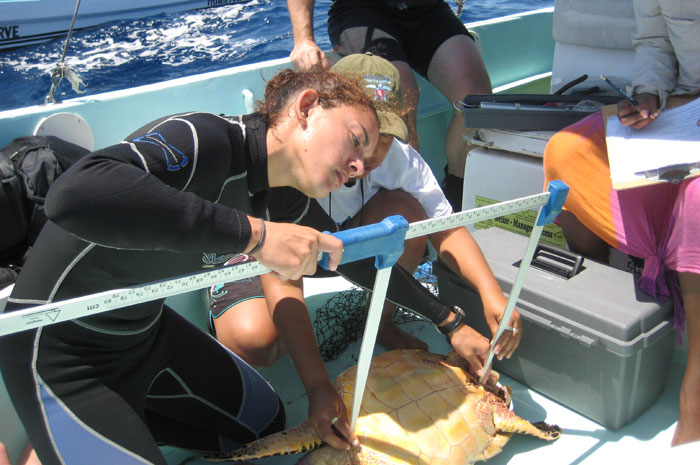When you Google “turtle” in Belize these days it’s likely to be a hands-on affair.
Volunteers from Google and Belize teamed up with marine scientists from the Wildlife Conservation Society (WCS), Hol Chan Marine Reserve and the University of Belize’s Environmental Research Institute to do a bit more than just search for turtles – they also captured, recorded and tagged the at-risk marine creatures before releasing them back into the sea.
The annual sea turtle survey has been in place since 2007 to provide important information to help safeguard the survival of these beautiful creatures who occupy such an important niche in the Belize Great Barrier Reef biosphere, the Caribbean Sea and the world.
“The data collected during the surveys will help us answer a number of questions on these species, ranging from how many sea turtles might live in this area to how exactly they use their environment,” Robin Coleman, the Wildlife Conservation Society ‘s Belize Assistant Country Director and survey leader said.
This is the second straight year that WCS worked with volunteers from Google on the sea turtle survey, and this time around they recorded 90 sea turtles, 75 of which were the critically endangered Caribbean hawksbill turtles. The team also hand- captured 27 sea turtles – 24 hawksbills, 2 greens and one loggerhead.
Once aboard a research vessel, the captured turtles were measured, weighed, and tagged by WCS Belize staff members. And one lucky young green sea turtle was fitted with a SPOT satellite tag, which will allow researchers to follow its movements after it leaves Glover’s Reef Atoll.
The turtles were also given health check- ups and supplied blood and tissue samples for pathogenic, molecular, and genetic testing. The team also collected barnacles, algae, and other parasites to get a better understanding of how where the turtles pick up these sea going hitchhikers.
All in all it sounds like a very cool project, and anything that increases our understanding of our aquatic neighbours is obviously of great value. As we mentioned in an earlier blog (22 July), the Belize Great Barrier Reef is an important source of information and a good indicator of the region’s – and the world’s – marine health.
As Dr Caleb McClennen, who directs the WCS’s Marine Program, put it, “The Annual Sea Turtle Survey is a great opportunity to learn valuable information about the biology and ecology of sea turtles (which is) vital for effective management plans.”
Here at Chaa Creek and the Belize Natural History Centre, we’re always checking up on Belize’s stunning Caribbean coast with its hundreds of lovely little cayes and the Belize Great Barrier Reef, the world’s second largest after Australia’s and we applaud the volunteers who lend their time and energy to contribute to keeping it healthy. By continually monitoring the area we have a better understanding of how it’s doing and how to best use the scant resources available to look after it.
It’s been said that knowledge is power, and knowledge is also protection, especially in this rapidly changing world where we are only just beginning to understand the impact that we, as a species, are having on the environment we share with so many other living creatures.
So the next time we use Google (probably in the next ten minutes or so) we’ll give a silent thanks for their volunteers and welcome them back for next year’s survey.
It’s always good to see these examples of good corporate citizenship, and we can only hope that more companies follow Google’s example.
Photo credit: http://www.wcs.org
